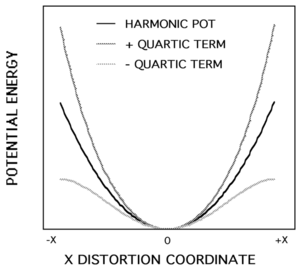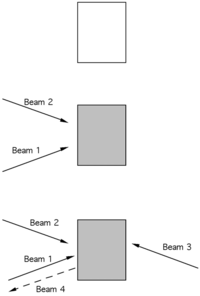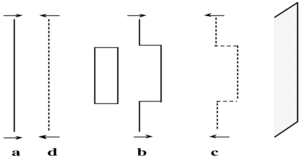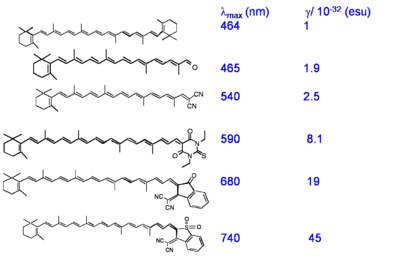Difference between revisions of "Introduction to Third-order Processes and Materials"
| Line 81: | Line 81: | ||
=== Third Harmonic Generation and the Optical Kerr Effect === | === Third Harmonic Generation and the Optical Kerr Effect === | ||
If we reconsider equation ( | If we reconsider equation (2) for the expansion of dipole moment of a molecule as a function of electric field and assume that the even-order terms are zero (i.e., that the molecule is centrosymmetric), and we apply an oscillating field at frequency \omega;: | ||
:<math> | :<math>E = E_0 cos(\omega t) \,\!</math> | ||
The dipole moment of the molecule becomes: | |||
:<math>\mu | :<math>\mu = \alpha E_0 cos(\omega t) + (1/6) \gamma E_0^3cos^3 (\omega t) + ...\,\!</math> (3) | ||
From trigonometry it can be shown that: | |||
:<math>cos^3(\omega t) = (3/4) cos(\omega t) + (1/4) cos (3\omega t)\,\!</math> (4) | |||
Substituting (4) in (3), we obtain | |||
:<math>\mu= \mu_0+ | :<math>\mu = \mu_0+ \alpha E_0 cos(\omega t) + (1/6) \gamma E_0^3 (3/4) cos(\omega t) + (1/6) \gamma E_0^3 (1/4) cos (3\omega t)\,\!</math> | ||
or, equivalently: | |||
:<math>\mu= \mu_0+ [\alpha +(1/6) \gamma E_{0}^{2}(3/4)]E_0cos(\omega t) + (1/6) \gamma E_0^3(1/4)cos(3\omega t)\,\!</math> (5) | |||
Thus, the | Thus, the material has an effective polarizability that depends on E<sub>0</sub><sup>2</sup> (the maximum deviation of the sinusoidal electric field) and γ. This is called Kerr effect. | ||
E<sub>0</sub><sup>2</sup> is always positive. On the other hand γ can be either positive or negative. Thus by increasing the magnitude of the electric field (i. e. the intensity of the light, as this is proportional to E<sub>0</sub><sup>2</sup> ) in the materials the polarizability of the material increases if γ is positive and decreases if γ is negative). If E is the electric field of an electromagnetic wave, due to a third order effect the linear polarizability can be changed simply by modifying the intensity of the applied light (because the light intensity is proportional to E<sub>0</sub><sup>2</sup>. | |||
This component of the dipole moment or polarization oscillates at the same frequency of the input field, ω. We note that the :<math>[\alpha + (1/6) \gamma E_{0}^{2}(3/4)]\,\!</math> term of equation (5) is similar to the term leading to the linear electrooptic effect or the Pockels effect. | |||
There are two kinds of Kerr effects. | |||
In an optical frequency Kerr effect a very high intensity beam is used to changed the refractive index of a material at the same frequency the beam. | |||
The DC Kerr effect or the quadratic electro-optic effect involves a low intensity beam combined with an oscillating applied voltage that can modulate the refractive index. | |||
It can be seen that eq (5) also contain a term at frequency 3&omega, the third harmonic of the incident field: | |||
:<math> (1/6) \gamma E_0^3(1/4)cos(3\omega t)\,\!</math> | |||
The magnitude of this component depends on &gamma. | |||
Thus, the interaction of light with third-order NLO material will create a polarization component at its third harmonic. | |||
Likewise, at the macroscopic level, in the presence of a strong laser beam at frequency ω the bulk material will have an induced polarization at 3&omega, due to χ^(3). This process is called third-harmonic generation | |||
== Four Wave Mixing == | == Four Wave Mixing == | ||
Revision as of 18:37, 8 June 2010
| Return to Third-order Processes, Materials & Characterization Menu | Next Topic |
The term "third order nonlinear optical (NLO) materials" refers to materials whose polarization depends on the intensity of an applied electromagnetic field. This intensity dependence gives rise to a variety of useful properties such as self-focusing, two-photon absorption, and third harmonic generation.
Nonlinear Susceptibility and Hyperpolarizability
For a material in an electric field, the bulk polarization, P, can be expanded as follows :
- <math>P = P_0 + \chi^{(1)}·E + (1/2)\chi^{(2)}·· E^2 + (1/6)\chi^{(3)}···E^3+ ...\,\!</math> (1)
where:
- <math>P_0\,\!</math> is the polarization in the absence of a field (some materials, such as polyvinylene difluoride when poled, can have a finite bulk polarization in the absence of an applied field),
- <math>\chi^{(1)}\,\!</math> is the susceptibility of the material (which is related to the dielectric constant; see [[1]]),
- <math>\chi^{(2)}\,\!</math> and <math>\chi^{(3)}\,\!</math> are the second- and third-order susceptibilities, respectively,
- <math>E\,\!</math> is the applied electric field,
(more generic expressions can be written instead of (1), if more than one field is present).
Because of symmetry, <math>\chi^{(2)}\,\!</math> is non-zero only if the material is not centrosymmetric overall (i.e., a centrosymmetry arrangement of noncentrosymmetric molecules leads to <math>\chi^{(2)}\,\!</math> = 0). Similarly, higher order <math>\chi^{(n)}\,\!</math> with even n are zero in centrosymmetric materials. There are no symmetry restrictions, instead, on <math>\chi^{(n)}\,\!</math> when n is odd (that is, these susceptibilities can be finite in centrosymmetric materials). P and E are vectors and the linear susceptibility <math>\chi^{(1)}\,\!</math> is a 3 x 3 tensor; the susceptibilities <math>\chi^{(n)}\,\!</math> are higher-order tensors (3 x 3 x 3 for n = 2, 3 x 3 x 3 x 3 for n = 3, etc.). The specific component of the relevant tensor is usually represented by subscripted indices (e.g., <math>\chi_{ijk}^{(2)}\,\!</math>, where i, j, k are one of the cartesian coordinates). The linear and nonlinear susceptibilities depend on the frequency/frequencies (wavelength/wavelengths) of the electromagnetic field and are material's properties. Nonlinear contributions to the material's polarization becomes more important with increasing field strength, since they scale with higher powers of the field.
Taylor Expansion for Molecular Dipole Moment
In a manner similar to (1), at the molecular level, the dipole moment of a molecule, μ, is affected by an external electric field and it can be expanded in a Taylor series as a function of the field:
- <math>\mu = \mu_0 + \alpha E + (1/2)\beta ·· E^2 + (1/6)\gamma ···E^3+ ...\,\!</math> (2)
where:
- <math>\mu_0\,\!</math> is the permanent dipole of the molecule,
- <math>\alpha\,\!</math> is the polarizability of the molecule (the microscopic equivalent to <math>\chi^{(1)}\,\!</math>),
- <math>\beta\,\!</math> and <math>\gamma\,\!</math> are the first and second hyperpolarizabilities, respectively.
As for the susceptibilities, <math>\alpha\,\!</math>, <math>\beta\,\!</math>, and <math>\gamma\,\!</math> are tensors of progressively higher rank, are frequency dependent, and each component can be a complex quantity. <math>\beta\,\!</math> is zero for centrosymmetric molecules.
Under normal conditions,
- <math>\alpha_{ij} E_j > \beta_{ijk} E_j · E_k > \gamma_{ijkl} E_j · E_k · E_l \,\!</math>
(here we have introduced the subscript to identify a specific component of the tensor and vectors; i, j, k, l = x, y, z). However, for field strengths large enough or for specific frequencies of the electromagnetic field, one of the nonlinear terms may become the dominant contribution to the dipole moment. Typically, high intensity laser beams are need for the effects of the hyperpolarizabilities to become observable.
Third-order Nonlinear Polarization of Matter
It can be shown that the description of Eq. (2) above corresponds to the behavior of a molecule in an anharmonic potential well. Second-order NLO effects arose from a cubic component in the potential as a function of displacement from the equilibrium position. A quartic term in the potential is at the origin of third-order effects. This is illustrated in the graph at right. If the correction is added in a positive way the well becomes steeper, adding the correction in a negative way the potential well is more shallow. The change is symmetric with respect to x = 0. These curves shown are greatly exaggerated, in reality the deviation would be less than the thickness of the lines as they are drawn. For the most part during normal oscillations the electrons are held within a quadratic potential. Only when there is a large electric field is there a deviation of the electron from their resting position to the point where these terms (terms which account for anharmonicity) are manifested in any significant way. When a restoring force of x4 is added to a molecule the polarization deviates from that characteristic of the harmonic potential. A greater displacement means that it is getting harder to polarize the molecule the greater the difference between the harmonic potential and the quartic potential. A material with a greater susceptibility has a higher refractive index (and a higher dielectric constant). If, as you polarize this material more and more it becomes harder to polarize, its susceptibility decreases with the field, as does its refractive index.
Third-Order NLO Effects
Nonlinear Self-Focusing
Let's consider a beam of light propagating into a NLO material with a positive nonlinear refractive index. If the intensity distribution in the beam is higher in the center than at the edge, the material that is near the center of the beam, where the intensity is highest will have a higher refractive index than the material at the edge of the beam profile, where there is low intensity. The refractive index changes because in this NLO material the polarizability (and susceptibility) depends in the intensity of the light, and thus the refractive index is also intensity dependent. As the refractive index in now different across the beam profile, the different portions of the beam will be refractive to different degrees, in particular the rays near the optical axis are refractive more than rays farther away from the axis. Thus this NLO material behaves like a lens that focuses light that propagates through it. In a focusing beam the cross-sectional area of the beam decreases as you approach the focal point and the intensity increases (because there are more photons in a unit area). So as a beam becomes focused the added intensity increases the refractive index further, causing even more focussing, higher intensity at the center of the beam and more change in refractive index. This process is called “nonlinear self-focusing”.

All materials (including glass and air) have third order non-linear optical effects. Sometimes these effects can lead to catastrophic self-focusing, leading to the destruction of the material when the intensity becomes too high. Usually, a material with fewer defects is the less likely it is be damaged (or will damage at higher intensities). Catastrophic self-focusing thus poses limits to the maximum intensities within optical materials, for example those used in lasers. When are doing experiments involving frequency tripling researchers use perfect defect-free crystals.
In an NLO material in which polarization decreases with the light intensity (a material with a negative nonlinear refractive index), the opposite effect is observed: the refractive index encountered by the beam while propagating in the medium is smaller at the center of the beam and larger near the edges, leading to self-defocusing of the beam. Thus, the beam passing through this material has a tendency to spread out.
Positive and negative γ and positive and negative χ(3) lead to different effects. Specifically, negative χ(3) leads to self-defocusing, and positive χ(3) leads to self-focusing.
See Wikipedia Self Focusing
See also Encyclopedia of Laser Physics Self Focusing
Third Harmonic Generation and the Optical Kerr Effect
If we reconsider equation (2) for the expansion of dipole moment of a molecule as a function of electric field and assume that the even-order terms are zero (i.e., that the molecule is centrosymmetric), and we apply an oscillating field at frequency \omega;:
- <math>E = E_0 cos(\omega t) \,\!</math>
The dipole moment of the molecule becomes:
- <math>\mu = \alpha E_0 cos(\omega t) + (1/6) \gamma E_0^3cos^3 (\omega t) + ...\,\!</math> (3)
From trigonometry it can be shown that:
- <math>cos^3(\omega t) = (3/4) cos(\omega t) + (1/4) cos (3\omega t)\,\!</math> (4)
Substituting (4) in (3), we obtain
- <math>\mu = \mu_0+ \alpha E_0 cos(\omega t) + (1/6) \gamma E_0^3 (3/4) cos(\omega t) + (1/6) \gamma E_0^3 (1/4) cos (3\omega t)\,\!</math>
or, equivalently:
- <math>\mu= \mu_0+ [\alpha +(1/6) \gamma E_{0}^{2}(3/4)]E_0cos(\omega t) + (1/6) \gamma E_0^3(1/4)cos(3\omega t)\,\!</math> (5)
Thus, the material has an effective polarizability that depends on E02 (the maximum deviation of the sinusoidal electric field) and γ. This is called Kerr effect. E02 is always positive. On the other hand γ can be either positive or negative. Thus by increasing the magnitude of the electric field (i. e. the intensity of the light, as this is proportional to E02 ) in the materials the polarizability of the material increases if γ is positive and decreases if γ is negative). If E is the electric field of an electromagnetic wave, due to a third order effect the linear polarizability can be changed simply by modifying the intensity of the applied light (because the light intensity is proportional to E02.
This component of the dipole moment or polarization oscillates at the same frequency of the input field, ω. We note that the :<math>[\alpha + (1/6) \gamma E_{0}^{2}(3/4)]\,\!</math> term of equation (5) is similar to the term leading to the linear electrooptic effect or the Pockels effect.
There are two kinds of Kerr effects. In an optical frequency Kerr effect a very high intensity beam is used to changed the refractive index of a material at the same frequency the beam.
The DC Kerr effect or the quadratic electro-optic effect involves a low intensity beam combined with an oscillating applied voltage that can modulate the refractive index.
It can be seen that eq (5) also contain a term at frequency 3&omega, the third harmonic of the incident field:
- <math> (1/6) \gamma E_0^3(1/4)cos(3\omega t)\,\!</math>
The magnitude of this component depends on &gamma. Thus, the interaction of light with third-order NLO material will create a polarization component at its third harmonic. Likewise, at the macroscopic level, in the presence of a strong laser beam at frequency ω the bulk material will have an induced polarization at 3&omega, due to χ^(3). This process is called third-harmonic generation
Four Wave Mixing
Third harmonic generation is a four wave mixing process. Three waves (electric 1, 2 and 3) interact in a material to create a fourth wave. In the case of third harmonic generation with single beam of light the three fields are degenerate; electric field 1 has the same frequency, phase and momentum (k-vect) as electric field 2 and three.
This does not have to be case. There could be three beams with different phases at arbitrary directions, polarizations and frequency components that can all mix and give sums and differences of frequency leading to all kinds of output light.
- <math>\omega 1 + \omega 2 + \omega 3\,\!</math> : this is third harmonic generation
or
- <math>\omega 1 + \omega 2 - \omega 3\,\!</math> : this gives light out at the same frequency (degenerate four wave mixing) as the input leading to the self-focusing effect.
Another interesting manifestation of third-order NLO effect is degenerate four wave mixing in which two beams of light interacting within a material create an interference pattern that will lead to a spatially periodic variation in light intensity across the material. As we have noted before the induced change in refractive index of a third-order nonlinear optical material is proportional to the intensity of the applied field. Thus, if two beams are interacting with a third-order NLO material, the result will be a refractive index grating because of constructive and destructive interference. The diffraction pattern creates areas of high and low light intensity on an NLO material. The areas that are brightest will have an increased refractive index (with a positive χ(3)). At the darkest point the refractive index will have zero change. So if the intensity is changing periodically then the refractive index will have a periodic variation as well. When a third beam is incident on this grating a fourth beam, called the phase conjugate, is diffracted from the grating. This process is called four wave mixing: two writing beams and a probe beam result in a fourth phase conjugate beam.
Degenerate Four-wave Mixing
A potential use of Degenerate Four-wave Mixing (DFWM) is in phase conjugate optics.
If two beams are directed on a material they create a diffractive index grating. A beam of light has a momentum determined by the direction it is traveling. If the beams of light mix and do not transfer energy to the material the momentum must be conserved. Two counter propagating beams (with the same phase) have a momentum sum of zero.
Phase conjugate optics takes advantage of a special feature of the diffracted beam: its path exactly retraces the path of one of the writing beams.
- As a result, a pair of diverging beams impinging on a phase conjugate mirror will converge after "reflection".
- In contrast, a pair of diverging beams reflected from an ordinary mirror will continue to diverge.
Thus, distorted optical wavefronts can be reconstructed using phase conjugate optical systems.
Phase Conjugation
A diverging set of beams reflected off of a normal mirror continues to diverge. (left) A diverging set of beams reflected off of a phase conjugate mirror exactly retrace their original path and are recombined at their point of origin. (right)
Phase Conjugate Mirror
A planar wave (a) passes through a distorting material (b) that introduces an aberration and the light interacts with a phase conjugate mirror (c) creating the phase conjugate wavefront. (d) Phase conjugate wave passes through the distorting material on the reverse path canceling the original aberration thus producing an undistorted wavefront.
A wavefront is made up a lot of beams traveling in the same direction a through a medium. Some aberration (with lower refractive index) in the material allows a portion of the light to go faster causing a bump in the wavefront. When the wavefront hits the phase conjugate mirror all parts are reversed. The part of the beam that comes into the mirror first ends up leaving last; there is a time reversal. When the reversed beam travels back and encounters the original aberration the distortion is removed.
In the following Flash animation a wavefront of light passes through a material with uneven index of refraction. Select either "normal mirror" or "phase conjugate mirror" to see the effect on the final wavefront after passing through the medium twice.
<swf width="500" height="400">http://depts.washington.edu/cmditr/media/conjugatemirror.swf</swf>
There are applications for this when looking at distant objects that have passed through a material that is scattering. If you bounce the light off a phase conjugate in two passes and you can get back the original undistorted image. This is useful for targeting applications and for looking at images on the Earth from a satellite where there are distortions due to inhomogeneities the atmosphere. This is a third order non linear optical effect.
See wikipedia http://en.wikipedia.org/wiki/Nonlinear_optics#Optical_phase_conjugation
Second Hyper-polarizability and BOA
The curve in red shows γ as a function of BOA as it goes from a polyene limit, through cyanine-like limit, up to a zwitterionic polyene limit. γ is calculated using perturbation theory. It starts positive, goes up, goes through zero and has negative peak at the cyanine-like limit and then comes back up and is positive.
The simplified perturbation expression for γ that involves three expressions, dubbed n (negative), tp (two photon) and d (dipolar because it only comes into effect when there is a change in dipole between the ground and the excited state.)
- <math>\gamma \propto - \left ( \frac {\mu^{4}_{ge}} {E^{3}_{ge}} \right) + \sum_{e^\prime} \left( \frac {\mu^{2}_{ge} \mu^{2}_{ee^\prime}} {E^{2}_{ge} E_{ge^\prime}} \right ) + \left ( \frac {\mu^{2}_{ge} (\mu_{ee} - \mu_{gg})^{2}} {E^{3}_{ge}} \right )\,\!</math>
N the transition dipole moment between the ground and the initial site (coming in at the 4th power) divided by the energy gap between those two states.
Ge is the transition dipole moment between and the excited state squared, and between the excited state and a higher lying excited state squared.
Two energy terms goes between the ground and the excited state squared and the other between the ground and the higher excited state.
The final term should look a lot like β. The difference in dipole moment is squared so that it always positive, the energy term is cubed. It starts at the zero, increases to maximum and then return to zero.
The calculation gives γ using this model which is plotted as open blue circle. These look a lot like the red dots.
Each term contributes to the resulting curve for γ.
Third-order Nonlinear Optical Properties of Polarized Polyenes
Beta carotene is the pigment found in margarine. By adding stronger and stronger acceptors it is polarized. λ max increases by a factor of 45.
The real part of the refractive index is related to how light is diffracted, the imaginary part is related to absorption of light.
The same is true about γ. Molecules will have both real and imaginary parts to γ. The real part refers to how the refractive index is changed as light of a given intensity goes through it. The imaginary part is related to two photon absorption.
In order to make useful devices like the Mach Zehnder interferometer you want the index of refraction to change but don’t want to lose light in the material. ELO materials can lose transparency due to absorption or scattering. They can also lose transparency at a high intensity due to the process of two photon absorption. Dipolar molecules tend to have large positive γ but also tend to have high two photon absorption cross sections.
Recently we have discovered that molecules with negative γ that have verge large real parts that lead to interesting optical effects; in certain spectral regions their imaginary part is almost zero so there is no light lost due to two photon absorption. These are good candidates for all optical switching applications because until now molecules with high χ(3) have had a high a loss due to two photon absorption.
see also All Optical Switching
| Return to Third-order Processes, Materials & Characterization Menu | Next Topic |




